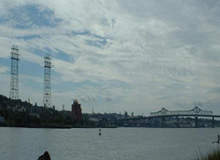
Weavers Cove LNG project was an East Coast-based liquid natural gas (LNG) terminal, proposed in 2003. The developer was Weaver’s Cove Energy (a subsidiary of Hess Corporation) and the project plan involved the construction of a new LNG regasification terminal on a 73 acre site at the east side of the Taunton River at the north end of Fall River in Massachusetts (2 miles north of Battleship Cove).
The project was abandoned by Hess LNG in June 2011 due to fall in prices of natural gas as a result of increase in production from shale resources in North America.
Project background
The project was expected to comprise of a single storage tank, a single berthing pier, a regasification train and processing equipment, and support buildings (the site was previously an oil storage facility). As an alternative there were also plans to provide offshore berthing facilities in Mount Hope Bay to receive LNG tankers and offload the cargo LNG, which was planned to be transferred via buried insulated transfer lines to the onshore facility for processing and regasification.
The delivered gas was planned to be regasified and passed to local and national pipelines or transported as a liquid via truck to peak shaving storage tanks in the area. The environmental impact certification process was completed in 2006 with a final compliance with the MEPA (Massachusetts Environmental Policy Act).
In April 2008 the pre-filing process with FERC for offshore berth and transfer system was started and other necessary federal, state and local permits have also been applied in the past six months (April-September 2008). The facility is expected to be in operation by 2011-2012. FERC granted an extension on the 2010 completion date in August 2008 so the facility must now be completed by November 2015.
Equipment
The project constituted a single 200,000m³ storage tank with a full containment design, capable of handling 4.3BCF of gas equivalent. Full containment meant a double skin (tank within a tank) for the tank, the inner skin made of 9% nickel steel and the outer tank made of thick pre-stress steel reinforced concrete.
A vaporisation system capable of sending out 800 million cubic feet per day at peak capacity (normal capacity of more like 400 million cubic feet per day) was also planned. A ship unloading jetty capable of handling standard capacity LNG tankers of 145,000m³ capacity through which the processed gas can be transported from the LNG facility in the majority via two pipeline connections with the Algonquin Transmission system (construction by Mill River Pipeline) were also part of the project.
Berthing facility
The berthing facility at Weavers Cove was designed to accommodate LNG tankers (950ft long, 150ft wide and with a loaded draft of 37.5ft), which require significant dredging operations to be undertaken in parts of the Taunton River (Federal Channel) and Hope Mount Bay (removal of some 2.5 million cubic yards of material) including modification of the turning basin in front of the new receiving terminal.
Processing facilities
The processing facilities comprising of pumps, piping, heat exchangers, odourisation equipment, metering facilities and control systems were expected to produce gas from the LNG and deliver it to the pipeline grid where an odourant (usually dimethyl sulphide) was to be injected and mixed into the gas, as required by the US Department of Transportation safety standards adopted by the gas pipeline and distribution companies because natural gas in its untreated state has no smell. The heat for the exchangers was to be provided by a hot water/glycol mixture heated in natural gas-fired boilers.
Pipeline connections
The two new pipelines leading from the terminal measuring 24in in diameter were to be designated the western lateral and the northern lateral. The western lateral was planned to be 2.55 miles long and run under the Taunton River in a westerly direction, then in established rights of way to a new metering station and into the Algonquin pipeline.
The northern lateral on the other hand, with a length of 3.54 miles was expected to run within the route of an existing Shell Oil pipeline. It was meant to use this established right of way for the majority of its route to the Algonquin Gas Transmission Company pipeline in Freetown.



